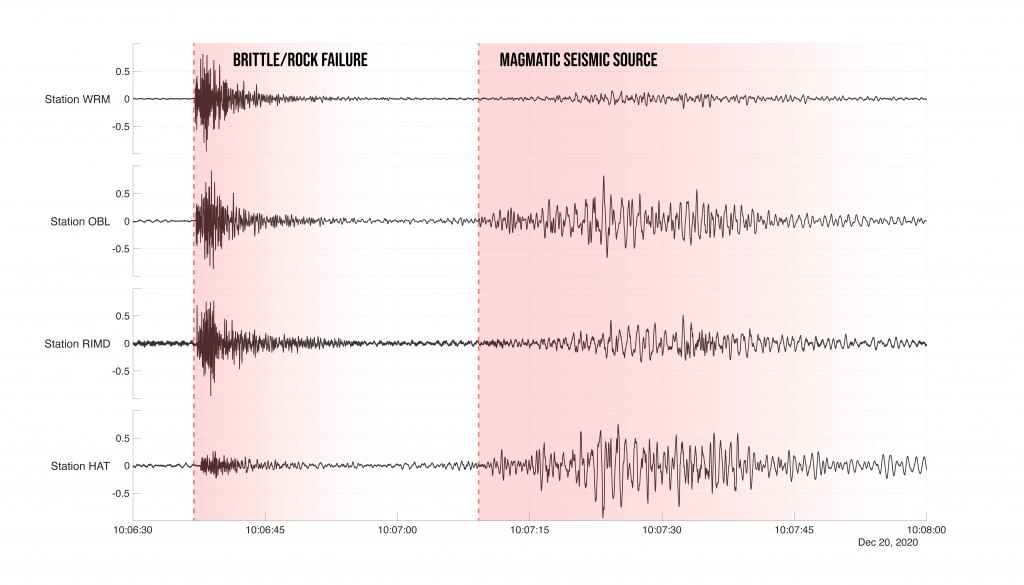Volcano Watch – Seismic Halfalogues: Earthquakes Are Only Part of the Conversation
From US Geological Survey Hawaiian Volcano Observatory scientists and affiliates. This week’s article was written by Hawaiian Volcano Observatory Geophysicist Jefferson Chang.
The journey from volcanic repose to a climactic eruption is like a mystery movie that keeps you at the edge of your seat. The story is filled with twists and turns that often lead to dead ends.

(Public domain.)
Earthquakes are a volcano observatory’s early warning system; the first page of action in our page turning story. It’s very difficult to move molten magma through solid rock without making some sort of “noise” or vibration that isn’t picked up by seismometers. So we often “hear” magma coming before it erupts as lava at the surface.
Earthquakes by themselves aren’t enough. Each person at the U.S. Geological Survey’s Hawaiian Volcano Observatory (HVO) plays an essential role in studying, monitoring, and responding to the volcanic hazards on the Island of Hawai‘i. We are all after the same thing—to unravel the clues of volcanic unrest so no one is caught off-guard when the plot turns towards an inevitable eruption.
Fundamentally, we use observations based on the five senses: sight, smell, touch, taste, and sound; but enhanced with modern instrumentation, for continuous and more precise monitoring. Each of these techniques require different sets of skills and background, so we work together to give the public the best information available.
For sight, instead of eyes, we maintain watch with cameras deployed at different places around the island that are likely to give us the first hints of volcanic activity. We also monitor how the ground is moving up and down or sideways, using very precise tiltmeters and GPS instruments that measure changes down to less than a millimeter, or tiny fractions of an inch.
For smell, instead of the nose, we have gas sensors that are tuned to detect volcanic gases. These include carbon dioxide, sulfur dioxide, hydrogen sulfide, and others, which let us know how deep or shallow the magma may be, depending on how much of these gases are escaping to the surface.
For touch, instead of the skin, we monitor temperatures by thermal cameras or temperature probes. Obviously the higher the temperature, the more likely it is that magma is closer to the surface, but in times of an eruption, the temperature of the lava can also tell us where the flow is likely most active and, in turn, most hazardous.
For taste, which is basically a chemistry experiment that involves the tongue (something no one should ever try with lava), we sample rocks and lava in the field to analyze their chemical composition.
For sound, instead of the ears, we listen to the ground with seismometers that can detect vibrations, which the volcanoes emit whenever a fault slips during an earthquake or when magma moves underground. This is where I play my part at HVO as part of a team that monitors the seismicity under the Island of Hawai‘i.
Part of monitoring the seismicity is locating and sizing-up the earthquakes: the ramp-up in the number of detected events is the monologue of volcanic unrest; the large powerful earthquakes are those indelible moments people quote with significant eruptions. For those playing along in the whodunit, these earthquakes statistics seem like a straightforward way to follow the plot.
The lesser-known art of monitoring seismicity deals with magmatic signals. These signals mostly appear as noise with interspersed tectonic events that may help decode what the magma is actually doing. These events are typically undetected by automated computer algorithms (created for tectonically active regions like California) and their sources are notoriously difficult to locate quantitatively, which means they are under-reported in seismic catalogs.
This is where the human ability of pattern recognition becomes indispensable. HVO seismic analysts look at waveform data day in and day out (literally), looking for patterns amidst the seemingly chaotic mess of wiggles to make sense of it all.
Volcano seismology is more than just transcribing earthquakes in tallies or almanacs. Seismic sleuths need to pay attention to the entire soundtrack—this includes the magma-related seismicity that often goes unnoticed but is critical in determining momentum and mood, and ultimately deciphering the eruption story as it unfolds.
Volcano Activity Updates
Kīlauea is not erupting. Its USGS Volcano Alert level is at ADVISORY).
Lava supply to the Halemaʻumaʻu lava lake has ceased and sulfur dioxide emissions have decreased to near pre-eruption background levels. Summit tiltmeters recorded one deflation-inflation cycle over the past week. Seismicity remains stable overall, with approximately 450 earthquakes over the past week (similar to previous weeks). There are currently no indications suggesting that a resumption of volcanic activity is imminent. Kīlauea remains an active volcano and future eruptions are possible at the summit or elsewhere on the volcano.
Mauna Loa is not erupting and remains at Volcano Alert Level ADVISORY. This alert level does not mean that an eruption is imminent or that progression to an eruption from the current level of unrest is certain.
This past week, about 166 small-magnitude earthquakes were recorded below Mauna Loa. Global Positioning System (GPS) measurements show low rates of deformation in the summit region over the past week. Gas concentrations and fumarole temperatures at both the summit and at Sulphur Cone on the Southwest Rift Zone remain stable. Webcams show no changes to the landscape.
There were 6 events with 3 or more felt reports in the Hawaiian Islands during the past week: a M3.6 earthquake 16 km (9 mi) ESE of Naalehu at 36 km (22 mi) depth on June 23 at 8:22 a.m. HST, a M3.3 earthquake 27 km (16 mi) WNW of Puako at 37 km (23 mi) depth on June 20 at 9:36 p.m. HST, a M3.5 earthquake 10 km (6 mi) ENE of Pāhala at 32 km (20 mi) depth on June 17 at 5:00 p.m. HST, a M2.1 earthquake 8 km (4 mi) ENE of Pāhala at 32 km (20 mi) depth on June 17 at 4:40 p.m. HST, a M4.5 earthquake 8 km (4 mi) ENE of Pāhala at 32 km (20 mi) depth on June 17 at 4:32 p.m. HST, and a M2.5 earthquake 15 km (9 mi) S of Fern Forest at 5 km (3 mi) depth on June 17 at 12:31 p.m. HST.
HVO continues to closely monitor both Kīlauea and Mauna Loa for any signs of increased activity.
Volcano Watch is a weekly article and activity update written by US Geological Survey Hawaiian Volcano Observatory scientists and affiliates.








